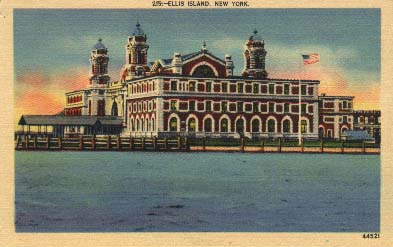
News & announcements
Saving your history
Early accounts
Maps
Nearby towns
People
Churches
Schools
Municipal
Organizations
Businesses
The mines
Transportation
Streets
Buildings
Entertainment
Celebrations
Sports
Ethnic groups
Ethnic groups
What's on this page:
- Thoughts on our immigrant history
- Rusyn textbook from St. Mary's School
- Freeland churches listed by founding ethnic group
- St. Ann School Guild cookbook, treasured recipes by Freeland area cooks ---NEW!---
OUR IMMIGRANT HISTORY
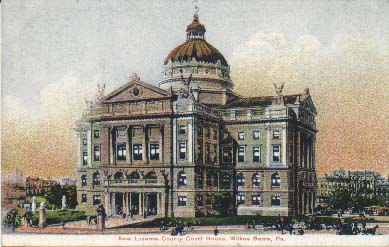 Freeland has a
complex cultural history, enriched by the various ethnic
groups that came to the Freeland area to live. Earliest
settlers were English, German, Welsh. They were joined by
Irish, and by other groups: Italians, Slovaks, Poles,
Hungarians (Magyars), Jews, Lithuanians, Tyroleans,
Carpatho-Ruthenians, Portuguese, and others. Immigrants came
to the U.S. through a small number of specially designated
ports, the most well-known being Ellis Island, pictured at
the top of this page. Often, but not always, the new
immigrants would eventually begin the process of
naturalization and then become citizens. Paperwork relating
to this process would be filed at the Luzerne County
courthouse in Wilkes-Barre, shown at left, and they are
still stored there today.
Freeland has a
complex cultural history, enriched by the various ethnic
groups that came to the Freeland area to live. Earliest
settlers were English, German, Welsh. They were joined by
Irish, and by other groups: Italians, Slovaks, Poles,
Hungarians (Magyars), Jews, Lithuanians, Tyroleans,
Carpatho-Ruthenians, Portuguese, and others. Immigrants came
to the U.S. through a small number of specially designated
ports, the most well-known being Ellis Island, pictured at
the top of this page. Often, but not always, the new
immigrants would eventually begin the process of
naturalization and then become citizens. Paperwork relating
to this process would be filed at the Luzerne County
courthouse in Wilkes-Barre, shown at left, and they are
still stored there today. 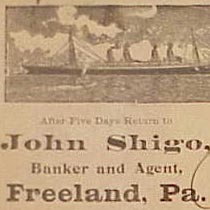 Many immigrants came
because they had heard that there was work here; often
someone they knew had come over earlier and sent back
reports. Occasionally mine operators even hired agents to go
to Europe and recruit workers. While many immigrants put
down roots in their new home, not everyone stayed. Some
immigrants came with the short-term goal of simply making
money to take back to the old country, and others came
alone, working and sending money back to their families.
Some made the trip back and forth across the ocean more than
once. Meanwhile, here in the "new country," some Freelanders
such as John Shigo (Cajko in the old country) did a good
business as shipping agents, helping immigrants to send
goods and money as well as helping them to travel overseas
themselves.
Many immigrants came
because they had heard that there was work here; often
someone they knew had come over earlier and sent back
reports. Occasionally mine operators even hired agents to go
to Europe and recruit workers. While many immigrants put
down roots in their new home, not everyone stayed. Some
immigrants came with the short-term goal of simply making
money to take back to the old country, and others came
alone, working and sending money back to their families.
Some made the trip back and forth across the ocean more than
once. Meanwhile, here in the "new country," some Freelanders
such as John Shigo (Cajko in the old country) did a good
business as shipping agents, helping immigrants to send
goods and money as well as helping them to travel overseas
themselves.RUSYN LANGUAGE TEXTBOOK FROM ST. MARY'S SCHOOL

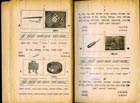
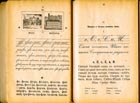 This Rusyn textbook, in use
in St. Mary's in the 1920s and perhaps later, is an
interesting piece of Freeland's history. St. Mary's was
founded by Carpatho-Ruthenian immigrants, whose children
were taught Rusyn in school to maintain a cultural
connection with the old country. The book was given to me by
a classmate, Patricia Bzdil (now Patricia Paul), and so it's
thanks to her that it's online here.
This Rusyn textbook, in use
in St. Mary's in the 1920s and perhaps later, is an
interesting piece of Freeland's history. St. Mary's was
founded by Carpatho-Ruthenian immigrants, whose children
were taught Rusyn in school to maintain a cultural
connection with the old country. The book was given to me by
a classmate, Patricia Bzdil (now Patricia Paul), and so it's
thanks to her that it's online here.
As an aside, the effects of the American melting pot took
hold over several decades. By the time I attended school
at St. Mary's in the 1950s, we were no longer taught to
read, write and speak Rusyn. We did, however, learn to
pray in Rusyn (referred to as Porusski - the Slovak word
for Russian language, but in this case it was Rusyn), we
were given dual language prayerbooks for our First Holy
Communion ("Heavenly Manna - Nebesnaja Manna"), and we
sang the mass in Porusski six days a week. That linguistic
connection was all but obliterated when the Vatican
decreed that Catholic masses would only be celebrated in
English.
1917 Rusyn
language textbook from St. Mary's School - Clicking
this link will open an Adobe PDF file of the textbook. If
you don't have Adobe Reader on your computer you can
download it for free at <www.adobe.com>. This
textbook PDF size = 3.2 MB.